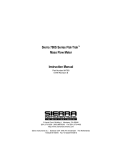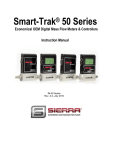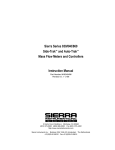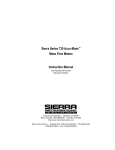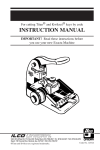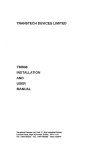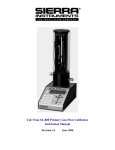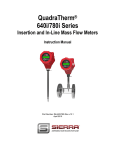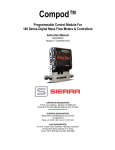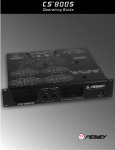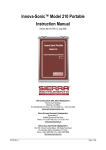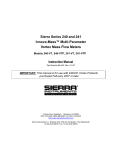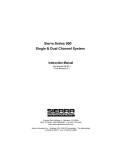Download Sierra 820 Automobile Parts User Manual
Transcript
Series 820 Instruction Manual Table of Contents Sierra 820 Series Top-Trakª Mass Flow Meters Instruction Manual Part Number IM-82 Revision C 06-99 5 Harris Court, Building L Monterey, CA 93940 (831) 373-0200 (800) 866-0200 Fax (831) 373-4402 http://www.sierrainstruments.com Sierra Instruments b.v. Bolstoen 30A 1046 AV Amsterdam The Netherlands +31(0)20-6145810 Fax +31(0)20-6145815 IM-82-C 0-1 Table of Contents Series 820 Instruction Manual Customer Notice Sierra Instruments, Inc. is not liable for any damage or personal injury, whatsoever, resulting from the use of Sierra Instruments standard mass flow meters or controllers for oxygen gas. You are responsible for determining if this mass flow meter or controller is appropriate for your oxygen application. You are responsible for cleaning the mass flow meter or controller to the degree required for your oxygen flow application. © COPYRIGHT SIERRA INSTRUMENTS 1994 No part of this publication may be copied or distributed, transmitted, transcribed, stored in a retrieval system, or translated into any human or computer language, in any form or by any means, electronic, mechanical, manual, or otherwise, or disclosed to third parties without the express written permission of Sierra Instruments. The information contained in this manual is subject to change without notice. TRADEMARKS Top-Trakª and Cal-Benchª are trademarks of Sierra Instruments, Inc. Other product and company names listed in this manual are trademarks or trade names of their respective manufacturers. All Sierra products are Year 2000 compliant. 0-2 IM-82-C Series 820 Instruction Manual Table of Contents Table of Contents Chapter 1 Introduction Introduction.............................................................1-1 Using this Manual .................................................1-1 Safety Information.................................................1-2 Receipt of System Components..................................1-2 Technical Assistance ..............................................1-2 Top Trak Features......................................................1-3 The 820 Series Flow Sensing Principle .............................1-4 Chapter 2 Installation Installation Overview ..................................................2-1 Installing the Transducer ..............................................2-2 Compression Fittings .............................................2-2 VCO Fittings .......................................................2-2 VCR Fittings .......................................................2-3 All 1/2-inch Size Connections....................................2-3 Wiring the Transducer.................................................2-4 Standard 0-5 VDC Output Signal Wiring.......................2-5 Optional 4-20 mA Output Signal Wiring........................2-5 Remote Display Installation...........................................2-6 Chapter 3 Operation Transducer Operation..................................................3-1 Transducer Accuracy..............................................3-1 Referencing the Transducer to Non-Standard Conditions . . . .3-2 Transducer Over-Ranging ........................................3-2 Zero and Span Adjustments ......................................3-3 Chapter 4 Maintenance and Repair Transducer Cleaning...................................................4-1 Flow Path Cleaning Model 822/824 .................................4-2 Inlet and Outlet Screens...........................................4-2 Laminar Flow Element............................................4-3 Flow Path Cleaning Model 826/827 .................................4-4 Laminar Flow Element............................................4-4 Flow Path Cleaning Model 822-S/824-S............................4-5 Laminar Flow Element............................................4-5 Sensor Cleaning and Inspection .................................4-8 Transducer Calibration ................................................4-9 Transducer Troubleshooting........................................ 4-11 Returning Equipment to the Factory ............................... 4-12 IM-82-C 0-3 Table of Contents Series 820 Instruction Manual Appendix A Conversion Formulas and Gas Tables Appendix B Production Specifications List of Figures 1-1. 1-2. 1-3. 2-1. 2-2. 2-3. 2-4. 2-5. 2-6. 4-1. 4-2. 4-3. 4-4. 4-5. 4-6. 4-7. 0-4 Top-Trak Features (Typical)..................................1-3 Flow Paths through the Transducer..........................1-4 Flow Measuring Principle.....................................1-4 Piping Requirements for 1/2-inch Size Connections.......2-3 Transducer D-Connector Pin Assignments .................2-4 Standard 0-5 VDC Output Signal Wiring ...................2-5 Single Transducer Current Loop Connection...............2-5 Multiple Transducer Current Loop Connections ...........2-6 Mounting the Remote Display ................................2-6 Model 822/824 Flow Components...........................4-2 Correct LFE Position ..........................................4-3 Model 826/827 Flow Components...........................4-4 Low Flow Transducer LFE Cleaning........................4-5 Medium Flow Transducer LFE Cleaning ...................4-6 High Flow Transducer LFE Cleaning .......................4-7 Printed Circuit Board Component Locations ............. 4-10 IM-82-C Series 820 Instruction Manual Table of Contents Cautions Caution! Only qualified personnel should install the transducer. Caution! Do not supply +DC power at the D-connector while using a power supply at the power jack. Both supplies may be damaged. Caution! Operating a 12 VDC transducer at 24 VDC will cause equipment damage. Caution! Only qualified personnel should perform transducer service, calibration or troubleshooting procedures. Caution! When using toxic or corrosive gases, purge the unit thoroughly with inert dry gas before disconnecting from the gas line. Caution! Printed circuit boards are sensitive to electrostatic discharge. To avoid damaging the board, follow these precautions to minimize the risk of damage: · · · IM-82-C before handling the assembly, discharge your body by touching a grounded, metal object handle all cards by their edges unless otherwise required when possible, use grounded electrostatic discharge wrist straps when handling sensitive components 0-5 Table of Contents 0-6 Series 820 Instruction Manual IM-82-C Series 820 Instruction Manual Chapter 1 Introduction Chapter 1 Introduction This instruction manual covers the installation, operation and maintenance of SierraÕs 820 Series product line including the following Top-Trakª Models: · 822 Mass Flow Meter with display (nylon flow body) · 824 Mass Flow Meter without display (nylon flow body) · 826 Hi-Flow Meter with display (aluminum flow body) · 827 Hi-Flow without display (aluminum flow body) · 822-S Mass Flow Meter with display (stainless steel flow body) · 824-S Mass Flow Meter without display (stainless steel flow body) SierraÕs Top-Trakª Mass Flow Meters are designed for precise measurement of gas mass flow. The 820 Series offers a broad range of sizes and process connections for flexibility and versatility. The primary standard calibration ensures starting point accuracy and NIST traceability. The meterÕs 0-5 VDC or 4-20 mA output signal is provided for recording, data-logging or control. The optional display reads the mass flow rate directly in engineering units or percentage of full scale. Using This Manual This manual is organized into four chapters: · Chapter 1 includes the introduction and theory of operation · Chapter 2 provides installation and wiring instructions · Chapter 3 describes transducer operation and features · Chapter 4 covers maintenance, calibration and troubleshooting Gas tables and conversion formulas are found in Appendix A. The product specifications and dimensional drawings are found in Appendix B. Throughout this manual, we use the word transducer as a generic term to represent all models of SierraÕs 820 Series Top-Trak Mass Flow Meters. IM-82-C 1-1 Chapter 1 Introduction Series 820 Instruction Manual Safety Information Caution and warning statements are used throughout this book to draw your attention to important information. Warning! Caution! This statement appears with information that is important to protect people and equipment from damage. Pay very close attention to all warnings that apply to your application. This statement appears with information that is important for protecting your equipment and performance. Read and follow all cautions that apply to your application. Receipt of System Components When receiving a Sierra transducer, carefully check the outside packing carton for damage incurred in shipment. If the carton is damaged, notify the local carrier and submit a report to the factory or distributor. Remove the packing slip and check that all ordered components are present and match your specifications (as ordered). Make sure any spare parts or accessories are not discarded with the packing material. Do not return any equipment to the factory without first contacting Sierra Customer Service. Technical Assistance If you encounter a problem with your transducer, review the configuration information for each step of the installation, operation and set up procedures. Verify that your settings and adjustments are consistent with factory recommendations. Refer to Chapter 4, Troubleshooting, for specific information and recommendations. If the problem persists after following the troubleshooting procedures outlined in Chapter 4, contact Sierra Instruments by fax or by E-mail (see inside front cover). For urgent phone support you may call (800) 866-0200 or (831) 373-0200 between 8:00 a.m. and 5:00 p.m. PST. In Europe contact Sierra Instruments bv at +31 20 6145810. When contacting Technical Support, make sure to include this information: · · · 1-2 the flow range, serial number, Sierra order number and model number (all marked on the transducer nameplate) the problem you are encountering and any corrective action taken application information (gas, pressure, temperature, pipe and fitting configuration) IM-82-C Series 820 Instruction Manual Chapter 1 Introduction Top-Trak Features Standard Top-Trak Mass Flow Meters require a 12 to 15 VDC external power source (24 VDC input power optional). The transducerÕs 0 to 5 VDC output signal allows for flow recording, data-logging or control. A 4 to 20 mA output signal is optionally available. Input power and output signal connections are made via the 9-pin sub-type D-connector located on the side of the transducer. An additional input power jack is located just below the D-connector. (It is important to connect input power at only one location.) The transducer shown below is a typical example of a 822 Series Top-Trak Mass Flow Meter. Other models may vary slightly in their appearance but are operationally equivalent. Figure 1-1. Top-Trak Features (Typical) IM-82-C 1-3 Chapter 1 Introduction Series 820 Instruction Manual The 820 Series Flow Sensing Principle The operating principle of Top-Trak transducers is based on heat transfer and the first law of thermodynamics. During operation process gas enters the instrumentÕs flow body and divides into two flow paths, one through the sensor tube, the other through the laminar flow element bypass. The laminar flow bypass generates a pressure drop, P1ÐP2, forcing a small fraction of the total flow to pass through the sensor tube (m1). Figure 1-2. Flow Paths through the Transducer Two resistance temperature detector (RTD) coils around the sensor tube direct a constant amount of heat (H) into the gas stream. In actual operation, the gas mass flow carries heat from the upstream coil to the downstream coil. The resulting temperature difference (DT) is detected by the RTD coils and gives the output signal. Since the molecules of the gas carry away the heat, the output signal is linearly proportional to gas mass flow. Figure 1-3. Flow Measuring Principle 1-4 IM-82-C Series 820 Instruction Manual Chapter 2 Installation Chapter 2 Installation Installation Overview To ensure a successful installation, inlet and outlet tubing should be clean and free from burrs or rims caused by cutting prior to plumbing the transducer into the system. The protective caps covering the inlet/outlet fittings should not be removed until immediately prior to installation. Before installing the transducer, verify the following: 1. Make sure the installation site meets the specific operating parameters recorded on the transducer’s nameplate. Each transducer is factory-configured for a specific gas and flow range. If the operating pressure is more than 50 psi (3.4 bar) away from the calibration pressure, it is advisable to return the unit to the factory for re-calibration. (Adjusting zero may be sufficient to remain within specification.) 2. Do not locate the transducer in areas subject to sudden temperature changes, moisture, drafts or near equipment radiating significant amounts of heat. Make sure to allow adequate space for cable connectors and wiring. 3. For 1/2-inch size inlet/outlet process connections on models 826 and 827 make sure the location meets the minimum number of recommended pipe diameters upstream and downstream of the transducer. A minimum of 5 inches (127 mm) upstream and 21/2 inches (64 mm) downstream is always recommended. (not necessary for other models) 4. Horizontal mounting is preferable. Vertical mounting is possible with best results achieved when the factory calibration is specifically performed for vertical mounting. In vertical positions zero shift will occur depending on the gas pressure at zero flow. 5. If the gas contains any particulate matter, install an in-line filter prior to the transducer. Recommended filter size: 15 micron for flows of 10 sccm to 30 slpm, 30 micron for above 30 slpm. 6. If a potential over-flow condition exists, insert a valve or critical orifice in the line to limit flow to approximately 25 percent above the full scale range of the meter. 7. Confirm that the transducer o-ring material is compatible with the gas to be measured. 8. For remote displays, confirm the supplied cable is of sufficient length to connect the components. IM-82-C 2-1 Chapter 2 Installation Series 820 Instruction Manual Installing the Transducer Caution! Only qualified personnel should install the transducer. Follow the installation instructions that apply to your transducer’s process connection. For all 1/2-inch size process connections, observe the piping recommendations given on page 2-3. Before operation, all plumbing should be checked carefully for leaks and the transducer purged with dry nitrogen. Compression Fittings 1. Position the transducer with the flow direction arrow pointing downstream in the direction of flow. 1. Verify the position of the front and back ferrule. Insert the tubing into the fitting. Make sure that the tubing rests firmly on the shoulder of the fitting and that the nut is finger tight. (Do not mix or interchange parts of tube fittings made by different manufacturers.) 2. Hold the body steady with a backup wrench. For 1/2inch size, tighten the nut 1-1/4 turns from finger tight. For 1/8inch, 1/4-inch and 3⁄8-inch sizes, tighten only 3/4 turn from finger tight. Do not over-tighten! 3. Check the system’s entire flow path thoroughly for leaks. (Do not use liquid leak detectors, instead monitor pressure decay. Over-exposing the transducer to leak detector fluid may damage the unit.) VCO and VCR Fittings 1. Position the transducer with the flow direction arrow pointing downstream in the direction of flow. 2. Install new o-rings compatible with the gas to be used. (Do not mix or interchange parts of tube fittings made by different manufacturers.) 3. Hold the body steady with a backup wrench. Tighten the nut finger tight and then 1/4 turn tighter with a wrench. Do not over-tighten! 4. Check the system’s entire flow path thoroughly for leaks. (Do not use liquid leak detectors, instead monitor pressure decay. Overexposing the transducer to leak detector fluid may damage the unit.) 2-2 IM-82-C Series 820 Instruction Manual Chapter 2 Installation 1/4 Inch Female NPT (standard on nylon flow bodies) 1. Position the transducer with the flow direction arrow pointing downstream in the direction of flow. 2. Use a good quality paste pipe thread sealant. Apply to the pipe threads. 3. Tighten the pipe no more than 1 turn past hand-tight. Caution! Do not over-tighten, damage to the instrument may result. 4. Check the system’s entire flow path thoroughly for leaks. (Do not use liquid leak detectors, instead monitor pressure decay. Overexposing the transducer to leak detector fluid may damage the unit.) 1/2-Inch Size NPT Connections (Models 826,827 only) 1. Install a section of straight pipe at least ten pipe diameters in length upstream of the transducer. Also, allow at least five pipe diameters downstream for accurate operation. DO NOT use reducers. If the preceeding components in the flow path create disturbances extend the upstream pipe length. 2. Position the transducer with the flow direction arrow pointing downstream in the direction of flow. 3. Tighten fittings until leak tight (refer to published standards for specific recommendations). 4. Check the system’s entire flow path thoroughly for leaks. (Do not use liquid leak detectors, instead monitor pressure decay. Overexposing the transducer to leak detector fluid may damage the unit.) Figure 2-1. Piping Requirements for all 1/2-Inch Size Process Connections IM-82-C 2-3 Chapter 2 Installation Series 820 Instruction Manual Wiring the Transducer Caution! Do not supply +DC power at the D-connector while using a power supply at the power jack. Both supplies may be damaged. Standard Top-Trak™ transducers require a 12 to 18 VDC power supply (15 VDC nominal, 100 mA maximum). 24 VDC input power is optional. Transducers are connected to the power supply through either the dedicated DC power jack or through the 9-pin D-connector located on the side of the enclosure. Before powering the unit, check the transducer’s nameplate to confirm input power: • PV1 = 12 to 18 VDC • PV2 = 24 VDC Note: operating a 24 VDC transducer at 12 to 18 VDC will result in unreliable operation. Caution! Operating a 12 VDC transducer at 24 VDC will cause equipment damage. The transducer’s standard 0 to 5 VDC (4-20 mA optional) output signal is available through the D-connector. The mating connector is included with the transducer. Connection details are given on the following pages. When the transducer is configured for a remote display, signal connections are made via the 9-pin connector. Input power connections are not included in the standard interface cable. Remote display mounting dimensions are given at the end of this chapter. Figure 2-2. Transducer D-Connector Pin Assignments 2-4 IM-82-C Series 820 Instruction Manual Chapter 2 Installation Standard 0-5 VDC Output Signal Wiring The standard 0-5 VDC output signal flows from Pin 3 (0-5 VDC Out) through the load (1K Ohm minimum) to Pin 7 (Power Common). The figure below is a typical example of input power and output signal connections. Figure 2-3. Standard 0-5 VDC Output Signal Wiring Optional 4-20 mA Output Signal Wiring The optional 4-20 mA output signal flows from Pin 9 (4-20 mA Out) through the load (50 to 500 Ohms maximum) to Pin 7 (Power Common). The figure below is a typical example of input power and output signal connections. (Multiple transducer current loop output connections are given on the next page.) Figure 2-4. Single Transducer Current Loop Connection IM-82-C 2-5 Chapter 2 Installation Series 820 Instruction Manual Figure 2-5. Multiple Transducer Current Loop Connections Remote Display Installation Mount the remote display at a convenient location within reach of the supplied interface cable. The maximum cable length is 100 feet (30 m). Figure 2-6. Mounting the Remote Display 2-6 IM-82-C Series 820 Instruction Manual Chapter 3 Operation Chapter 3 Operation The output signal of the transducer is either 0-5 VDC (standard) or 4-20 mA (optional). The output signal is linear and proportional to the gas mass flow rate. For example, for a 0-5 VDC output signal, 5.00 VDC is the output signal for the full scale listed on the transducer’s nameplate, 2.50 VDC is for one-half of full scale, and 0.00 VDC is for zero flow. For a 4-20 mA output signal, 20.00 mA is the output signal for the full scale, 12.00 mA is for one-half of full scale, and 4.00 mA is for zero flow. Transducer Operation When the transducer is installed and the system has undergone a complete leak check: 1. Apply power. The output signal will be at a high level for the first 10 to 20 seconds while the sensor warms up to its normal operating temperature range. Assuming zero flow, the output signal will then drop to zero (or 4 mA, depending on output configuration). Allow at least thirty minutes of warm-up time. 2. For first-time start ups, perform an initial zero output check as described on page 3-3. After checking the initial zero setting, the transducer is ready to monitor the gas mass flow rate. Transducer Accuracy The standard accuracy of Top-Trak is ±1.5% of full scale. The ±1.5% of full scale accuracy means that the 0-5 VDC output signal is accurate to within ±0.1 VDC. The 4-20 mA output is accurate to within ±0.4 mA. For example, the output signal for zero flow can be as much as +0.1 VDC or +0.4 mA. If the transducer has an output signal at zero flow, as long as it is within either of these two ranges, it does not mean it is malfunctioning. For transducers with a digital display, the accuracy is simply 1.5 times the full scale flow rate stated on the nameplate. For example, if the full scale is 10 slpm, the digital display will be accurate to ±0.2 slpm. The reading at zero flow may be as much as +0.2 slpm and still be within the stated accuracy specification. IM-82-C 3-1 Chapter 3 Operation Series 820 Instruction Manual Referencing the Transducer to Non-Standard Conditions The gas flow rate output of your transducer is referenced to “standard” conditions of 21°C (70°F) and 760 mm of mercury (1 atmosphere) unless otherwise specified on the certificate of calibration. Check the stated reference conditions of your transducer. If you are comparing your transducer’s output with another type of flow meter, different reference conditions could cause a discrepancy between the flow readings. For example, the output reading of a Top-Trak will be approximately 7% lower when referenced to 0°C rather than 21°C. To find the flow rate referenced to other standard conditions or the actual temperature and pressure conditions in the pipe where your transducer is located, see Appendix A. Transducer Over-Ranging If the flow rate exceeds the full scale value listed on the transducer nameplate, the output signal and digital display (if so equipped) will read a higher value. The transducer is not calibrated for over-ranged flows and will probably be both non-linear and inaccurate. Overrange conditions are indicated by the display and/or output signal going to a level above the full scale range. When the over-range condition is removed, it may take several seconds for the transducer to recover and resume normal operation. If the supply voltage is only 12 VDC, the over-ranged reading may exceed the full scale value by 10% maximum. If the supply voltage is higher, as with the 24 VDC option, then the output can exceed the full scale by as much as 50%, or more. Digital displays cannot exceed 3-1/2 digits (1999). If the flow rate exceeds 1999, the rightmost digits will blank and only the left-hand “1” will appear on the display. 3-2 IM-82-C Series 820 Instruction Manual Chapter 3 Operation Zero and Span Adjustments The zero and span potentiometers are accessed through the ports marked on the side of the transducer. Normally, span adjustments are not made unless you are calibrating the transducer. The span adjustment should not be used unless you have a known, precise nonzero flow rate that you wish to match. Before making any zero adjustments, confirm that the system has reached its normal operating temperature and pressure and the transducer is mounted in its final position. For transducers without the digital display: 1. Power the transducer and allow at least 30 minutes of warm up time before attempting any adjustments. Set gas flow to zero. Confirm that no flow exists. 2. Connect a digital multimeter to Pin 3 (0-5 Out) or, Pin 9 (4-20 Out) and Pin 7 (Power Common). Check the reading. If it does not indicate 0± .05 VDC, (or 4.0± .016mA) adjust the zero potentiometer. Since the output does not indicate negative numbers, it is necessary to adjust down from a slightly positive reading. Begin by slowly rotating the zero pot clockwise until a positive reading is indicated. To complete the zero adjustment, slowly turn the pot counterclockwise until zero is achieved. For transducers with the digital display: 1. Power the transducer and allow at least 30 minutes of warm up time before attempting any adjustments. Set gas flow to zero. Confirm that no flow exists. 2. Observe the reading on the digital display. If the reading is greater than 1.5% of full scale, adjust the zero potentiometer. IM-82-C 3-3 Chapter 3 Operation 3-4 Series 820 Instruction Manual IM-82-C Series 820 Instruction Manual Chapter 4 Maintenance & Repair Chapter 4 Maintenance and Repair Caution! It is important that this transducer be serviced and/or calibrated by qualified personnel. Top-Trak™ transducers essentially require no scheduled maintenance other than periodic flow path cleaning if the gas is dirty. If an in-line filter is used, the filtering element should be periodically replaced or ultrasonically cleaned. Calibration of Sierra Instruments flow meters and controllers requires a calibrating standard of at least equal accuracy and preferably an order of magnitude better than the transducer, and a skilled factory technician familiar with the Top-Trak. It is recommended that Top-Trak meters be returned to the factory for annual evaluation and calibration. Included in this chapter are general instructions for: • Transducer Cleaning Instructions..........................page 4-1 • Transducer Calibration......................................page 4-9 • Transducer Troubleshooting..............................page 4-11 • Returning Equipment to the Factory.....................page 4-12 Transducer Cleaning Due to transducer design variations, separate cleaning instructions are given in this chapter for each of the following models: • • • Model 822/824 with nylon flow body Model 826/827 with aluminum flow body Model 822-S/824-S with stainless steel flow body When toxic or corrosive gases are used, the transducer must be thoroughly purged with inert dry gas before disconnecting from the gas line. If a transducer used with toxic or corrosive gas is returned to the factory, the transducer must first be purged clean. A Material Safety Data Sheet must be enclosed with the unit upon its return. IM-82-C 4-1 Chapter 4 Maintenance & Repair Series 820 Instruction Manual Flow Path Cleaning Model 822/824 Figure 4-1. Model 822/824 Flow Components Inlet and Outlet Screens 1. Remove the transducer from the system. Caution! When using toxic or corrosive gases, purge the unit thoroughly with inert dry gas before disconnecting from the gas line. 1. Remove inlet and outlet fittings. 2. Pull out the laminar flow element (LFE) holddowns. 3. Replace or clean the inlet and outlet screens. 4. Re-assemble components. When the transducer is installed in the system, leak test the connection. 5. To be within the original accuracy, calibrate the transducer (see page 4-9). 4-2 IM-82-C Series 820 Instruction Manual Chapter 4 Maintenance & Repair Laminar Flow Element The laminar flow element (LFE) is a precision flow divider which diverts a preset amount of flow through the sensor tube. The LFE is made of precision machined 316 stainless steel. The particular LFE used depends on the gas and flow range of the instrument. To clean or inspect the LFE: Caution! When using toxic or corrosive gases, purge the unit thoroughly with inert dry gas before disconnecting from the gas line. 1. Remove the transducer from the system. 1. Remove the inlet and outlet fittings. Pull out the LFE holddowns and inlet/outlet screens. 2. The LFE has a slightly tapered shape with the larger diameter on the upstream (inlet) side. To remove, use a blunt object which does not mar the flow channels to push the LFE from the outlet side to the inlet side. A 3/8-inch (9 mm) nut driver works well. 3. Clean the LFE using a suitable solvent. Make sure to carefully clean all active flow channels in the LFE. 4. Re-install the LFE making sure to press it in the correct distance as shown below. 5. Re-assemble remaining components. When the transducer is installed in the system, leak test the connection. Re-zero the transducer (see Chapter 3). Figure 4-2. Correct LFE Position IM-82-C 4-3 Chapter 4 Maintenance & Repair Series 820 Instruction Manual Flow Path Cleaning Model 826/827 Laminar Flow Element The laminar flow element (LFE) is a precision flow divider which diverts a preset amount of flow through the sensor tube. The particular LFE used depends on the gas and flow range of the instrument. To clean or inspect the LFE: Caution! When using toxic or corrosive gases, purge the unit thoroughly with inert dry gas before disconnecting from the gas line. 1. Remove the transducer from the system. 2. Remove the 6-32 hex nuts and washers. Remove the end caps. Note the position of the three (3) LFE elements. 3. To remove the LFE, use a blunt object which does not mar the flow channels to push the LFE from the flow body. 4. Clean the LFE using a suitable solvent. Make sure to carefully clean all active flow channels in the LFE. 5. Re-install the LFE making sure to position it with both ends even with the transducer flow body. 6. Re-assemble remaining components. When the transducer is installed in the system, leak test the connection. Re-zero the transducer (see Chapter 3). Figure 4-3. Model 826/827 Flow Components 4-4 IM-82-C Series 820 Instruction Manual Chapter 4 Maintenance & Repair Flow Path Cleaning Model 822-S/824-S Laminar Flow Element The laminar flow element (LFE) is a precision flow divider which diverts a preset amount of flow through the sensor tube. The LFE is made of precision machined 316 stainless steel. The particular LFE used depends on the gas and flow range of the instrument. Should the LFE require cleaning or inspection due to deposition, use the appropriate cleaning procedure which is specific to flow body size. Figure 4-4. Low Flow Transducer LFE Cleaning Low Flow Transducers: The LFE is accessed by unscrewing the main inlet fitting and removing it from the flow body. The LFE is screwed into the inlet fitting, which has been specially machined for this purpose. To access the components: 1. Remove the transducer from the system. Caution! When using toxic or corrosive gases, purge the unit thoroughly with inert dry gas before disconnecting from the gas line. 1. The inlet filter screen is held in place in the inlet fitting by the LFE. Disassemble by holding the fitting steady with a wrench and unscrewing the LFE with a medium flat-tipped screwdriver. 2. Remove the LFE assembly taking care not to bend the inlet screen. Inspect the sealing O-ring and replace if necessary. Inspect the inlet screen and replace if corroded or damaged. Light to medium particulate contamination can be cleaned by back washing with a suitable solvent. Air dry thoroughly. 3. Inspect the LFE for damage and replace if necessary. Replacement of the LFE or inlet screen requires transducer re-calibration. 4. Re-assemble components. When the transducer is installed in the system, leak test the connection. Re-zero the transducer (see Chapter 3). IM-82-C 4-5 Chapter 4 Maintenance & Repair Series 820 Instruction Manual Figure 4-5. Medium Flow Transducer LFE Cleaning Medium Flow Transducers: In the medium flow body, the LFE assembly consists of the honeycomb laminar flow element, inlet screen, 0.63 inch long standoff, two ranging washers, 2-1⁄4 inch long 4-40 screw and 4-40 nut. Range changes in the honeycomb element are made with various diameter ranging washers. To access the components: Caution! When using toxic or corrosive gases, purge the unit thoroughly with inert dry gas before disconnecting from the gas line. 1. Remove the unit from the system. 2. Access the LFE by unscrewing the four 10-32 socket head cap screws from the inlet side of the flow body and remove the inlet end cap. (Note the position of the screws, one has a shorter length.) 3. Remove the LFE assembly taking care not to bend the inlet screen. Inspect the sealing O-ring and replace if necessary. Inspect the inlet screen and replace if corroded or damaged. Light to medium particulate contamination can be cleaned by back washing with a suitable solvent. Air dry thoroughly. 4. Inspect the honeycomb element for damage and replace if necessary. Replacement of the LFE or inlet screen requires transducer re-calibration. 5. Re-assemble components. When the transducer is installed in the system, leak test the connection. 6. To be within the original accuracy, calibrate the transducer (see page 4-9). 4-6 IM-82-C Series 820 Instruction Manual Chapter 4 Maintenance & Repair Figure 4-6. High Flow Transducer LFE Cleaning High Flow Transducers: The high flow LFE is similar to the honeycomb element used in the medium flow body but larger in diameter. The high flow body consists of four parts: inlet tube, inlet cap, main flow body and end cap. The inlet tube is only removed to inspect and replace the sealing O-ring between the inlet tube and inlet cap. To access the components: Caution! When using toxic or corrosive gases, purge the unit thoroughly with inert dry gas before disconnecting from the gas line. 1. Remove the unit from the system. 2. To remove the inlet screen, remove the four 1⁄4-28 socket head cap screws on the inlet side of the flow body and separate the inlet cap from the main flow body. 3. Inspect the inlet screen for damage and corrosion and replace if necessary. Light to medium particulate contamination can be cleaned by back washing with a suitable solvent. Air dry thoroughly. 4. Inspect the sealing O-ring for damage and replace if necessary. The inlet screen is mounted with the fine mesh side facing the inlet. 5. To remove the LFE loosen and remove the four threaded rods holding the end cap to the main flow body. Separate the end cap from the main flow body and remove the LFE assembly. The LFE assembly consists of: 6-32 x 31⁄8 inch long screw, a #6 washer, two ranging washers, honeycomb laminar flow element, LFE, spacer, inlet filter, and 6-32 nut. 6. Inspect the honeycomb element for damage and replace if necessary. Replacement of the LFE or inlet screen requires transducer re-calibration. 7. Re-assemble components. When the transducer is installed in the system, leak test the connection. 8. To be within the original accuracy, calibrate the transducer (see page 4-9). IM-82-C 4-7 Chapter 4 Maintenance & Repair Series 820 Instruction Manual Sensor Cleaning and Inspection Due to sensor design variations, the following sensor cleaning instructions are for Model 822-S/824-S only. All other transducer models must be returned to the factory. Sensor cleaning is accomplished by simply rodding out the sensor with the Sensor Cleaning Stylette, part number “CK” available from Sierra. A 0.028 inch diameter piano wire may also be used. To access the sensor for inspection or cleaning: Caution! When using toxic or corrosive gases, purge the unit thoroughly with inert dry gas before disconnecting from the gas line. 1. Remove the transducer from the system. Remove the two socket head access port plugs with a 1⁄4-inch Allen wrench. Visually inspect the sensing ports and sensor. 1. Use a hemostat or tweezers to push the cleaning wire into the downstream opening of the sensor tube. Do not force the cleaning wire, move it back and forth–DO NOT TWIST OR ROTATE. 2. Flush the sensor tube with a non-residuous solvent compatible with the O-ring material. In cases where solids are deposited in sensor, units should be returned to factory for complete cleaning and re-calibration. 3. Blow dry all parts with dry nitrogen and re-assemble. When the transducer is installed in the system, leak test the connection. Re-zero the transducer (see Chapter 3). 4-8 IM-82-C Series 820 Instruction Manual Chapter 4 Maintenance & Repair Transducer Calibration Caution! It is important that this transducer be calibrated only by qualified personnel. Calibration of Sierra’s flow meters requires a calibration standard of at least four times the accuracy of the transducer. Sierra’s Cal-Bench Automated Primary Calibration System is the preferred method of calibration and is used at the factory for all calibrations from 10 sccm up to 50 slpm. Most calibrations can be performed with a digital voltmeter (DVM) or multimeter with 0.25% accuracy and four digits, dry nitrogen and the K-factor tables included in this manual. Flow meters require a metering valve for setting a constant flow rate. The following procedures are offered as guidelines for calibration. It is always best to return the transducer to the factory for calibration. Calibration checks and minor adjustments to the zero and full scale are made via the access ports in the enclosure. If the linearity needs adjustment (when installing a different bypass to change the range) skip Step 2 and Step 3. If linearity does not need adjustment, complete only Steps 1 through 3. Step 1. Warm Up Plug in the unit to be calibrated and allow at least 30 minutes warm up time before attempting any adjustments. Step 2. Zero Adjust Slide open the zero and span access doors. Connect a DVM or multimeter to the transducer output pins. Adjust the zero potentiometer for 0.0 volts (4 mA) at zero flow. Step 3. Check Full Scale Generate full scale flow using a metering valve in-line with the unit under test. Compare the indicated flow rate with the flow standard reading. If they agree to within ±10%, adjust the span potentiometer for exact agreement. If the readings do not agree within ±10%, attempt to determine the cause of disagreement. Possibilities are: • leaks in the system or in the transducer • wrong or improper use of K-factor • wrong or improper correction for temperature and pressure • partially clogged or dirty sensor tube • replacement of components in the flow path do not exactly match the original parts This completes transducer calibration. To adjust linearity, continue with Step 4. IM-82-C 4-9 Chapter 4 Maintenance & Repair Series 820 Instruction Manual Step 4. Adjusting Linearity First gain access to the printed circuit board inside the enclosure: 1. For units with the digital display, carefully rotate the display until it hits the top plate. Slide the display’s two side panels up and remove. Move the display aside taking care not to damage the connecting cable. 2. Remove the two Phillips head screws from the top of the transducer enclosure. Remove the two Phillips head screws from the back of the transducer enclosure. Pull the enclosure panels off. 3. Orient the transducer with the component side of the circuit board facing you. Plug in the transducer and allow to warm up for at least 30 minutes. Step 5. Zero Adjust Connect a DVM to the transducer output pins. Adjust the zero potentiometer for 0.0 volts (4 mA) at zero flow. Step 6. Calibrate 25% Use the calibration standard to set a flow rate of 25% of full scale. Adjust the span potentiometer for 1.25 volts (8 mA) at the output of the transducer. Step 7. Calibrate 50% Increase the flow rate to 50% of full scale. If the output is within +0.05 V (0.2 mA), no adjustment is necessary. If the output is beyond these limits, install a jumper block at J1 in the appropriate position (see Figure 4-7). Adjust R25 for the proper reading. Step 8. Calibrate 75% and 100% Set the flow to 75% of full scale. If the output is outside the limits set in Step 7, install a jumper block in J2 in the appropriate position. Adjust R27 for the correct reading. Repeat this procedure for 100% flow using R29. Repeat Steps 6 through 8 at least one more time. Figure 4-7. Printed Circuit Board Component Locations 4-10 IM-82-C Series 820 Instruction Manual Chapter 4 Maintenance & Repair Transducer Troubleshooting When you suspect that the transducer is not operating correctly, there are a few simple checks that can be made before taking the unit out of service: 1. Make certain that there are no leaks in the gas line. 2. Check that all cables are connected and are in good condition. 3. Verify that the power supply is in the correct range and properly connected to the transducer. 4. Double check connector pin outs when replacing another manufacturer’s transducer. This information is provided to help locate the cause of a transducer failure. It is not intended to be an all inclusive repair guide. For most repairs, the unit should be returned to the factory for service. Problem Possible Cause Solution No output No power Inlet filter screen clogged Clogged sensor PCB defective Plug in power supply Clean or replace screen Return to factory for cleaning* Return to factory for repair Unit will not zero Gas leak Application requires high pressure and non-horizontal mounting PCB defective Find and correct leaks Re-zero transducer (see Chapter 3) Return to factory for repair Reads full scale with no flow Gas leak Liquid present in system Defective sensor Find and correct leaks Check for liquid in flow path Return to factory for repair Output too high Incorrect calibration or K-factor Liquid present in system Defective sensor Correct calibration/k-factor Check for liquid in flow path Return to factory for repair Out of calibration Dirty or clogged sensor Change in composition of gas Gas leak LFE dirty Inlet filter screen clogged Incorrect inlet conditions (1/2-inch size models) PCB defective *Model 822-S/824-S see sensor cleaning instructions IM-82-C Return to factory for cleaning* See K-factory tables Find and correct leaks Clean LFE Clean or replace screen Re-plumb transducer correctly (See Chapter 2) Return to factory for repair 4-11 Chapter 4 Maintenance & Repair Series 820 Instruction Manual Returning Equipment to the Factory Factory Calibration—All Models Sierra Instruments maintains a fully-equipped calibration laboratory. All measuring and test equipment used in the calibration of Sierra transducers are traceable to NIST Standards. Sierra is ISO-9001 registered and conforms to the requirements of ANSI/NCSL-Z540 and ISO/IEC Guide 25. Instructions for Returning Your Instrument for Service The following information will help you return your instrument to Sierra Instruments' Factory Service Center and will ensure that your order is processed promptly. Prices may vary depending on the flow range, type of gas and operating pressure of your unit. To request detailed pricing contact your local Sierra Instruments distributor or contact one of our offices directly. Our expedite fees are: three-day turnaround 25%, two-day turnaround 40%. Please follow these easy steps to return your instrument for factory service: 1. Obtain a Return Materials Authorization Form (RMA) with assigned number from Sierra Instruments. You may obtain this from the factory by calling (800) 866 0200 between 8:00 a.m. and 5:00 p.m. PST Monday through Friday. You may also obtain this number via e-mail by contacting [email protected]. 2. Once you have obtained an RMA number, complete the form (one form can be used for multiple units). If you require service beyond calibration, but do not know which service(s) will be required, describe the symptoms as accurately as possible on the RMA form. Submit electronically or by fax to (831) 373-2414. 3. Pack your instrument carefully (bubble wrap or molded foam suggested-NOT PEANUTS) and include a copy of the RMA form (complete with Sierra supplied RMA number) with the unit(s). 4. Ship the unit(s) to the following address: 4-12 IM-82-C Series 820 Instruction Manual Chapter 4 Maintenance & Repair RETURN ADDRESS: Caution! Always fully neutralize any toxic gas trapped inside the instrument before removing it from the gas line. Sierra Instruments, Inc. Attention: Factory Service Center 5 Harris Court, Building L Monterey, CA 93940 USA CUSTOMER SERVICE AND SUPPORT INFORMATION: Email Technical Support: [email protected] Email Sales: [email protected] FACTORY USA (recommended): TOLL FREE: 800-866-0200 PHONE: 831-373-0200 FAX: 831-373-4402 EMAIL: [email protected] European Sales & Service Center: PHONE: +31 72 5071400 FAX: +31 72 5071401 EMAIL: [email protected] Asia Sales & Service Center: PHONE: + 86 203435 4870 FAX: +86 203435 4872 IMPORTANT SAFETY NOTE ABOUT PURGING WARNING: When toxic or corrosive gases are used, purge unit thoroughly with inert dry gas before disconnecting from the gas line to prevent personnel from being injured when coming in contact with the instrument. WARNING: If an instrument used with a toxic or corrosive gas is returned to the factory, a Material Safety Data Sheet (MSDS) must be enclosed & attached to the outside of the box to alert Sierra personnel of the potential hazard. Also, make sure the inlet & outlet are solidly plugged off. IM-82-C 4-13 Series 820 Instruction Manual Appendix A Appendix A Conversion Formulas and Gas Tables Conversion of Flow Rate to Other T and P Conditions The flow rate of your transducer is referenced to certain ÒstandardÓ conditions of temperature and pressure. Unless otherwise specified in your order, these standard conditions are 21°C (70°F) and 760 mm of mercury (1 atmosphere). If you wish to convert to other ÒstandardÓ conditions or to find the ÒactualÓ conditions in the pipe where your instrument is installed, use the following relationship: Q2 = P1 T2 P2 T1 Q1 (1) ( )1 = The standard conditions under which your instrument was calibrated, ( ) 2 = The new standard conditions or the actual temperature and pressure conditions in the pipe, Q1 = The gas mass flow rate referenced to the calibrated standard conditions (sccm or slm), Q2 = The gas mass flow rate referenced to the new standard or actual conditions (sccm or slmÑÒSÓ means Òstandard,Ó accm or almÑÒAÓ means ÒactualÓ), P = Absolute pressure (kg/cm2 or psia), and T = Absolute temperature (°K or °R) (°K = °C + 273, °R = °F + 460). Example 1: Changing ÒStandardÓ Conditions If your transducer has a flow rate reading of 10.00 slm and was calibrated at standard conditions of 70°F (21°C) and 1 atmosphere (14.7 psia), and if you wish to convert this reading to standard conditions of 32°F (0°C) and 1 atmosphere, then you would use Equation (1) as follows: Q2 = 14.7 460 + 32 14.7 460 + 70 (10.0) = 9.28 slm The flow rate referenced to 0°C will be approximately 7% lower than when referenced to standard conditions of 21°C. Example 2: Finding the ÒActualÓ Flow Rate If the flow rate and calibrated standard conditions are as given in Example 1 and you wish to find the actual flow rate at 100°F and 30 psig, then you would use Equation (1) as follows: Q2 = IM-82-C 14.7 460 + 100 14.7 + 30 460 + 70 (10.00) = 3.47 slm A-1 Appendix A Series 820 Instruction Manual Calculating For a Single Gas The following tables provide K-factors and thermodynamic properties of gases commonly used with mass flow meters and controllers. The purpose of these tables is two-fold: 1. Calibrating an ÒactualÓ gas with a reference gas. This is particularly useful if the actual gas is not a common gas or if it is toxic, flammable, corrosive, etc. 2. Interpreting the reading of a flow meter or flow controller which has been calibrated with a gas other than the actual gas. In applying the tables, the following fundamental relationship is used: Q1/Q2 = K1/K2 (1) Where: Q = The volumetric flow rate of the gas referenced to standard conditions of 0°C and 760 mm Hg (sccm or slm), K = The K-factor defined in equation (6), ( ) 1 = Refers to the ÒactualÓ gas, and ( ) 2 = Refers to the ÒreferenceÓ gas. The K-factor is derived from the first law of thermodynamics applied to the sensor tube, as described in Chapter 1: H = A-2 ¥ mC p DT N (2) IM-82-C Series 820 Instruction Manual Appendix A Where: H = The constant amount of heat applied to the sensor tube, ¥ = The mass flow rate of the gas (gm/min) m Cr = The coefficient of specific heat of the gas (Cal/gm); Cr is given in the Table (at 0°C), DT = The temperature difference between the downstream and upstream coils, and N = A correction factor for the molecular structure of the gas given by the following table: Number of Atoms in the Gas Molecule Monatomic Diatomic Triatomic Polyatomic N 1.040 1.000 0.941 0.880 ¥ can also be written as: The mass flow rate, m, ¥ = Q m r (3) Where: r = The gas mass density at standard conditions (g/l); r is given in the tables (at 0°C, 760 mm Hg). Furthermore, the temperature difference, DT, is proportional to the output voltage, E, of the mass flow meter, or DT = aE (4) where: a = A constant. If we combine equations (3) and (4), insert them into equation (2), and solve for Q, we get Q = (bN/rCp) (5) where: b = H/aE = a constant if the output voltage is constant. IM-82-C A-3 Appendix A Series 820 Instruction Manual For our purposes, we want the ratio of the flow rate, Q1, for an actual gas to the flow rate of a reference gas, Q2, which will produce the same output voltage in a particular mass flow meter or controller. We get this by combining equations (1) and (5): Q1/Q2 = K1/K2 = (N1/ r1Cp1)/(N2/r2CP2) (6) Please note that the constant b cancels out. Equation (6) is the fundamental relationship used in the accompanying tables. For convenience, the tables give ÒrelativeÓ K-factors, which are the ratios K1/K2, instead of the K-factors themselves. In the tables, the relative K-factor is Kactual/KN2 where the reference gas is the commonly used gas, nitrogen (N2). The remaining columns give Cp and r, enabling you to calculate K1/K2 directly using Equation (6). In some instances, K1/K2 from the tables may be different from that which you calculate directly. The value from the tables is preferred because in many cases it was obtained by experiment. Sierra calibrates every transducer with primary standards using the actual gas or a molecular equivalent reference gas. The calibration certificate accompanying the transducer cites the reference gas used. Example 1: A transducer is calibrated for nitrogen (N2), and the flow rate is 1000 sccm for a 5.000 VDC output signal. The flow rate for carbon dioxide at a 5.000 VDC output is: QCO2/QN2 = KCO2/K N2, or QCO2 = (0.74/1.000)1000 = 740 sccm Example 2: A transducer is calibrated for hydrogen (H2), and the flow rate is 100 sccm for a 5.000 VDC output signal. The flow rate for nitrous oxide (N2O) is found as follows: QN2O/QH2 = K N2O/K H2, or Q N2O = (0.71/1.01) 100 = 70.3 sccm Note that the K-factors relative to nitrogen must be used in each case. Example 3: We want a transducer to be calibrated for use with dichlorosilane (SiH2Cl2) at a 100 sccm full scale flow. We wish to use the preferred reference gas Freon-14 (CF4). What flow of CF4 must we generate to do the calibration? QSiH2CL2 /QCF4 = K SiH2CL2 /K CF4 100/Q CF4 = 0.869 Q CF4 = 100/0.869 = 115 sccm A-4 IM-82-C Series 820 Instruction Manual Appendix A Calculating Dual Gas Mixtures Equation (6) is used for gas mixtures, but we must calculate N/rCp for the mixture. The equivalent values of r, Cp, and N for a dual gas mixture are given as follows: The equivalent gas density is: ¥ /m ¥ )r + ( m ¥ /m ¥ )r r = (m 1 T 1 2 T 2 Where: ¥ = m ¥ + m ¥ = Total mass flow rate (gm/min), m T 1 2 ( )1 = Refers to gas #1, and ( )2 = Refers to gas #2 The equivalent specific heat is: C p = F1C p1 + F2C p2 Where: ¥ r )/(m ¥ r) and F1 = ( m 1 1 T ¥ r )/(m ¥ r) F2 = ( m T 2 2 The equivalent value of N is: ¥ /m ¥ ) N + (m ¥ /m ¥ )N N = (m 1 T 1 2 T 2 The equivalency relationships for r, Cp, and N for mixtures of more than two gases have a form similar to the dual-gas relationship given above. IMPORTANT NOTE ABOUT K-FACTORS: Please note that if you have a transducer calibrated for a gas such as methane and wish to use the K-factors to measure a gas such as air, that the inaccuracy of the measurement can range from ±5 to 10%. The use of K-factors is, at best, only a rough approximation and should not be used in applications that require a better than ±5 to 10% accuracy. It should also be noted that certain gases, in similar Òfamilies,Ó will work exceptionally well with K-factors; however, those instances are only true when similar thermal properties of the gas are present. IM-82-C A-5 Appendix A Series 820 Instruction Manual Gas Tables and K-factors Actual Gas Acetylene Air Allene (Propadiene) Ammonia Argon Arsine Boron Trichloride Boron Trifluoride Bromine Boron Tribromide Bromine Pentafluoride Bromine Trifluoride Bromotrifloromethane (Freon-13 B1) 1,3-Butadiene Butane 1-Butane 2-Butane 2-Butane Carbon Dioxide Carbon Disulfide Carbon Monoxide Carbon Tetrachloride Carbon Tetrafluoride (Freon-14) Carbonyl Fluoride Carbonyl Sulfide Chlorine Chlorine Trifluoride Chlorodifluoromethane (Freon-22) Chloroform Chloropentafluoroethane (Freon-115) Chlorotrifluromethane (Freon-13) Cyanogen Cyanogen Chloride Cychlopropane Deuterium Diborane Dibromodifluoromethane Dibromethane Dichlorodifluoromethane (Freon-12) Dichlorofluoromethane (Freon-21) Chemical Symbol K-factor Relative N2 Cp (Cal/g) Density (g/l) @ 0°C C 2H 2 .58 1.00 .43 .73 1.45 .67 .41 .51 .81 .38 .26 .38 .37 .4036 .240 .352 .492 .1244 .1167 .1279 .1778 .0539 .0647 .1369 .1161 .1113 1.162 1.293 1.787 .760 1.782 3.478 5.227 3.025 7.130 11.18 7.803 6.108 6.644 CO2 CS2 CO CCl4 CF4 .32 .26 .30 .324 .291 .74 .60 1.00 .31 .42 .3514 .4007 .3648 .336 .374 .2016 .1428 .2488 .1655 .1654 2.413 2.593 2.503 2.503 2.503 1.964 3.397 1.250 6.860 3.926 COF2 COS CL2 CIF 3 CHClF 2 .54 .66 .86 .40 .46 .1710 .1651 .114 .1650 .1544 2.945 2.680 3.163 4.125 3.858 CHCI 3 C 2CIF5 .39 .24 .1309 .164 5.326 6.892 CCIF 3 .38 .153 4.660 C 2N 2 CICN C 3H 5 D2 B2H6 CBr2F2 CCI2F2 .61 .61 .46 1.00 .44 .19 .47 .35 .2613 .1739 .3177 .1722 .508 .15 .075 .1432 2.322 2.742 1.877 1.799 1.235 9.362 7.76 5.395 CHCl 2F .42 .140 4.952 C 3H 4 NH 3 Ar AsH3 BCl3 BF3 Br2 Br3 BrF5 BrF3 CBrF3 C 4H 6 C4H10 C 4H 8 C 4H 8 CIS C4H8 TRANS Elastomer O-ring* NEO KR NEO NEO NEO * If no O-ring material is specified then O-ring to be used is Viton A-6 IM-82-C Series 820 Instruction Manual Actual Gas Dichloromethylsilane Dichlorosilane Dichlorotetrafluoroethane (Freon-114) 1,1-Difluoroethylene (Freon-1132A) Dimethylamine Dimethyl Ether 2,2-Dimethylpropane Ethane Ethanol EthylAcetylene Ethyl Chloride Ethylene Ethylene Oxide Fluorine Fluoroform (Freon-23) Freon-11 Freon-12 Freon-13 Freon-13 Freon-14 Freon-21 Freon-22 Freon-113 Freon-114 Freon-115 Freon-C318 Germane Germanium Tetrachloride Helium Hexafluoroethane (Freon-116) Hexane Hydrogen Hydrogen Bromide Hydrogen Chloride Hydrogen Cyanide Hydrogen Fluoride Hydrogen Iodide Hydrogen Selenide Hydrogen Sulfide Iodine Pentafluoride Isobutane Isobutylene Krypton Methane Methanol Methyl Acetylene Methyl Bromide Methyl Chloride Methyl Fluoride Appendix A Chemical Symbol K-factor Relative N2 Cp (Cal/g) Density (g/l) @ 0°C (CH3) 2SiCl2 SiH2Cl2 C2Cl2F4 .25 .40 .22 .1882 .150 .1604 5.758 4.506 7.626 C 2H 2F 2 .43 .224 2.857 (CH3) 2NH (CH3) 2O C3H12 C 2H 6 C 2H 6O C 4H 6 C2H 5CI C 2H 4 C 2H 4O F2 CHF 3 CCI 3F CCI2F2 CCIF 3 B1 CFrF3 CF4 CHCI 2F CHCIF 2 C2Cl2F4 C2ClF5 C 4F 6 GeH4 GeCL4 He C 2F 6 .37 .39 .22 .50 .39 .32 .39 .60 .52 .980 .50 .33 .35 .38 .37 .42 .42 .46 .20 .22 .24 .17 .57 .27 1.454 .24 .366 .3414 .3914 .4097 .3395 .3513 .244 .1365 .268 .1873 .176 .1357 .1432 .153 .1113 .1654 .140 .1544 .161 .160 .164 .185 .1404 .1071 1.241 .1834 2.011 2.055 3.219 1.342 2.055 2.413 2.879 1.251 1.965 1.695 3.127 6.129 5.395 4.660 6.644 3.926 4.952 3.858 8.360 7.626 6.892 8.397 3.418 9.565 .1786 6.157 C6H14 H2 HBr HCl HCN HF HI H2Se H 2S IF 5 CH(CH3)3 C 4H 8 Kr CH 4 CH3OH C 3H 4 CH2Br CH 3Cl CH 3F .18 1.01 1.000 1.000 1.070 1.000 1.000 .79 .80 .25 .27 .29 1.453 .72 .58 .43 .58 .1926 .68 .3968 3.419 .0861 .1912 .3171 .3479 .0545 .1025 .2397 .1108 .3872 .3701 .0593 .5328 .3274 .3547 .1106 2.253 .3221 3.845 .0899 3.610 1.627 1.206 .893 5.707 3.613 1.520 9.90 3.593 2.503 3.739 .715 1.429 1.787 4.236 CCI2FCCIF2 Elastomer O-ring* KR KR 1.518 * If no O-ring material is specified then O-ring to be used is Viton IM-82-C A-7 Appendix A Actual Gas Methyl Mercaptan Methyl Trichlorosilane Molybdenum Hexafluoride Monoethylamine Monomethylamine Neon Nitric Oxide Nitrogen Nitrogen Dioxide Nitrogen Trifluoride Nitrosyl Chloride Nitrous Oxide Octafluorocyclobutane (Freon-C318) Oxygen Difluoride Oxygen Ozone Pentaborane Pentane Perchloryl Fluoride Perfluoropropane Phosgene Phosphine Phosphorous Oxychloride Phosphorous Pentafluoride Phosphorous Trichloride Propane Propylene Silane Silicon Tetrachloride Silicon Tetrafluoride Sulfur Dioxide Sulfur Hexafluoride Sulfuryl Fluoride Teos Tetrafluorahydrazine Trichlorofluormethane (Freon-11) Trichlorisilane 1,1,2-Trichloro-1,2,2 Trifluorethane (Freon-113) Trisobutyl Aluminum Titanium Tetrachloride Trichloro Ethylene Trimethylamine Tungsten Hexasfuoride Uranium Hexafluoride Vinyl Bromide Vinyl Chloride Xenon Series 820 Instruction Manual Chemical Symbol K-factor Relative N2 Cp (Cal/g) Density (g/l) @ 0°C CH3SH (CH3) SiCl3 MoF6 C2H5NH2 CH3NH2 NE NO N2 NO2 NF3 NOCl N 2O C 4F 6 .52 .25 .21 .35 .51 1.46 .990 1.000 .74 .48 .61 .71 .17 .2459 .164 .1373 .387 .4343 .245 .2328 .2485 .1933 .1797 .1632 .2088 .185 2.146 6.669 9.366 2.011 1.386 .900 1.339 1.25 2.052 3.168 2.920 1.964 8.397 OF2 O2 O3 B5H9 C5HI2 CIO3F C 3F 8 COCl2 PH3 POCl3 PH5 PCl5 C 3H 8 C 3H 6 SiH4 SiCl4 SiF4 So2 SF6 SO2F2 .63 1.000 .446 .26 .21 .39 .174 .44 .76 .36 .30 .30 .36 .41 .60 .28 .35 .69 .26 .39 .090 .32 .33 .1917 .2193 .3 .38 .398 .1514 .197 .1394 .237 .1324 .1610 .1250 .3885 .3541 .3189 .1270 .1691 .1488 .1592 .1543 2.406 1.427 2.144 2.816 3.219 4.571 8.388 4.418 1.517 6.843 5.620 6.127 1.967 1.877 1.433 7.580 4.643 2.858 6.516 4.562 .182 .1357 4.64 6.129 CCl2FCClF2 .33 .20 .1380 .161 6.043 8.360 (C4H9)Al TiCl4 C2HCl3 (CH3)3N WF 6 UF6 CH 2CHBr CH 2CHCl Xe .061 .27 .32 .28 .25 .20 .46 .48 1.44 .508 .120 .163 .3710 .0810 .0888 .1241 .12054 .0378 8.848 8.465 5.95 2.639 13.28 15.70 4.772 2.788 5.858 N2F 4 CCl3F SiHCl3 Elastomer O-ring* KR KR * If no O-ring material is specified then O-ring to be used is Viton A-8 IM-82-C Series 820 Instruction Manual Appendix B Specifications Appendix B Product Specifications Operating Specifications Gases Most gases; check compatibility with wetted materials; specify when ordering Mass Flow Rates Models 822/824: 0 to 10 sccm to 0 to 50 slpm; Models 826/827: 0 to 75 slpm to 0 to 175 slpm; Models 822-S/824-S: 0 to 10 sccm to 0 to 500 slpm; flow ranges specified are for an equivalent flow of nitrogen at 760 mm Hg and 21°C (70°F); other ranges in other units are available (e.g. scfh or nm3/h) Gas Pressure Models 822/824:150 psig ( 10 barg) maximum, 20 psig (1.4 barg) optimum Models 826/827: 150 psig ( 10 barg) maximum, 20 psig (1.4 barg) optimum Models 822-S/824-S: 1000 psig (68.9 barg) maximum for low flow bodies only; 500 psig (34 barg) maximum; 20 psig (1.4 barg) optimum Gas & Ambient Temperature 32° to 122°F (0 to 50°C); higher available on special order Leak Integrity Models 822/824, 826/827: 1 X 10-4 atm cc/sec of helium maximum Models 822-S/824-S: 5 X 10-9 atm cc/sec of helium maximum Pressure Drop Models 822/824: Flow Rate 100 sccm 1 slpm 10 slpm 20 slpm 30 slpm 40 slpm 50 slpm cm of Water 0.06 0.6 6.0 24.0 54.0 96.0 130.0 mbar 0.06 0.59 5.88 23.5 53 94.7 127.4 in H2O 0.024 0.236 2.36 9.45 21.3 37.8 51.2 Models 826/827: Two inches of mercury maximum at 175 slpm 822/824-S (low).........0.08 psi (0.006 bar or 6 cm of water) differential max; 15 slpm: 1.5 psi (0.10 bar or 105 cm of water) differential max 822/824-S (med).......0.08 psi (0.006 bar or 6 cm of water) differential max; 100 slpm: 1.5 psi (0.10 bar or 105 cm of water) differential max 822/824-S (high)........0.08 psi (6 mbar or 6 cm of water) differential max; 300, 400 and 500 slpm: 2 psi (0.14 bar or 140 cm of water) differential maximum IM-82-C Power Requirements 12 to 18 VDC nominal, 100 mA maximum; 24 VDC optional Output Signal Linear 0-5 VDC, 1000 Ohms minimum load resistance Linear 4-20 mA, 30-500 Ohms maximum loop resistance Display 3.5 digit LCD (0.6 in H); remote mounting option available B-1 Appendix B Specifications Series 820 Instruction Manual Performance Specifications Accuracy ±1.5% of full scale including linearity over 15 to 25°C and 5 to 60 psia (0.3 to 4 bara) Repeatability ±0.5% of full scale Temperature Coefficient 0.08% of full scale per °F (0.15% of full scale per °C), or better Pressure Coefficient 0.01% of full scale per psi (0.15% of full scale per bar), or better Response Time 800 ms time constant; six seconds (typical) to within ±2% of final value over 25 to 100% of full scale Physical Specifications Wetted Materials 822/824: 10% glass-filled Nylon® 6/6, 316 stainless steel, nickel plating, Viton® o-rings standard, Neoprene® and 4079 Kal-Rez® (or equivalent) o-rings optional 826/827: Anodized aluminum, 316 stainless steel, nickel plating, Viton® o-rings standard, Neoprene® and 4079 Kal-Rez® (or equivalent) o-rings optional 822-S/824-S: 316 stainless steel, nickel plating, Viton® o-rings standard, Neoprene® and 4079 Kal-Rez® (or equivalent) o-rings optional B-2 IM-82-C Series 820 Instruction Manual IM-82-C Appendix B Specifications B-3 Appendix B Specifications B-4 Series 820 Instruction Manual IM-82-C













































